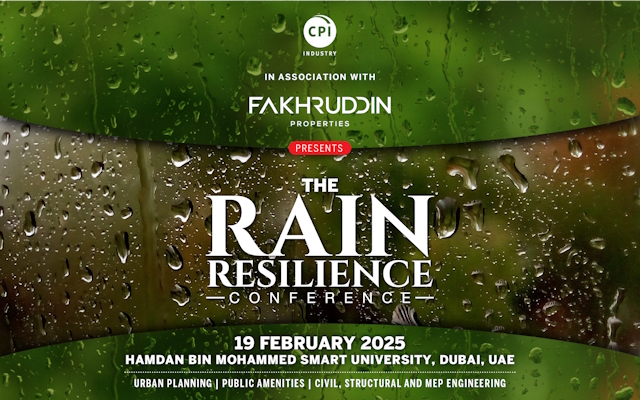

The unprecedented heavy rainfall on April 16, 2024 and the extent of its impact on some parts of the GCC region have demanded analysis and conscious effort towards arriving at strategies and solutions to prevent a repeat or, at the very least, to minimise the damage.
As Saeed Al Abbar, CEO, AESG, puts it, “Building resilience in cities is essential to not only make populations and infrastructure less susceptible to damage and loss but to also make them more agile to the unpredictable nature of climate change impacts. The urgency of climate change demands more than incremental change – it demands a revolution in how we approach infrastructure, where resilience is not just an aspiration; it’s an inherent feature of our infrastructure.
By integrating cutting-edge technology and appropriate sustainable architectural design and engineering considerations, we can develop infrastructure that stands the test of time.”
Such was the magnitude of the event that it calls on policymakers; urban planners; climate adapters; and civil, structural and MEP engineers to work together to provide long-standing solutions that are practical and within cost frameworks.
The Rain Resilience Conference is a coming together of multiple disciplines with an agenda of being able to bolster infrastructure and buildings and, thus, contribute to safe cities and business continuity.
THE conference includes a traditional mix of policy and regulation-related addresses, technical presentations, case study presentations, panel discussions, and focused and structured audience interactions to receive the maximum possible information from policymakers; master-planners, master developers; developers; HSE experts; architects; civil, structural and MEP consultants; civil, structural and MEP contractors; sectoral end-users (healthcare, hospitality, aviation, education, retail, etc.); manufacturers; suppliers; and O&M, FM and other specialised service providers.
1) Accepting the new normal of greater frequency and intensity of rainfall (flash floods).
2) Acknowledging that existing infrastructure and buildings need to be fortified to withstand the new normal – for example, flood relief and drainage systems are typically based on 50-100 years of historical data; regional government initiatives towards reevaluating the data and incorporating additional risk factors, using exaggerated figures as the new baseline for designing flood relief, plumbing and drainage systems.
3) At the same time, with cost in mind, a need for benchmarking against moderately rainy regions, as opposed to designing according to the Amazon rainforest – profiling parts of the globe that experience occasional flooding and integrating proven design standards in them into regional building practices.
4) A need for creating ‘basis of design’ for extreme weather events. A need to collectively examine the 200 countries around the world and create benchmarking data.
5) Accepting the need for embracing a new Project Development mindset (risk analysis, factoring in multiple possibilities); incorporating a new set of KPIs in New Construction with an idea of building resilience from the get go. ‘Value engineering’ as equated with cost savings, and the inherent risks involved – a need for rational cost-benefit analysis.
6) How to fund a revamp of infrastructure, buildings: Business models from around the world.
7) Horses for courses: Why the same design, construction and installation solutions or approaches cannot be applied across building types or purposes, such as hotels, airports, data centres, industrial areas and shopping malls.
8) The importance of collaboration and communication among all stakeholders to leverage their expertise, and develop integrated solutions that enhance building resilience and promote sustainable development amidst climate change challenges.
Gain Actionable Insights: Access advanced strategies for addressing IAQ challenges in the built environment.
Network & Collaborate: Connect with regulators, manufacturers, and suppliers to optimise decision-making.
Experience Live Solutions: Participate in live demonstrations and explore innovative exhibits showcasing real-world solutions.

Dr Mahmoud AlBurai
Senior Director, Real Estate Policies and Innovation Section
Dubai Land Department; Member, Board of Directors for the United Nations Private Sector Alliance to enhance disaster
preparedness, reduce impacts, and build sustainable resilience

Azmi S Aboulhoda
Managing Director
EMergy Consultancy

Surendar Balakrishnan
Co-Founder & Editorial Director
CPI Industry

George Berbari
CEO
DC PRO Engineering
Author, The Energy Budget

Prasanth Chakkingal
Senior VP
PNC Architects of Sobha Group

Aakash Dave
Consistent Engineering Consultants

Rishi Jain
Principal Public Health Engineer
Ramboll Engineers Company

Philip Keil
Associate Director
AESG

A.R. Suresh Kumar
Vice President & Head, IOBG
Voltas Limited

James Marvin
CEO
PNC Architects of Sobha Group

Frédéric Paillé
Co-Founder & Commercial
Director
CPI Industry

Balaskandan Raghunathan
Founder & Managing Director
Capital Engineering Consultancy

Sekhar Reddy
MAG Property Development
(MAG Group)

Rahul Shetty
Mechanical Engineer
Consistent Engineering Consultants